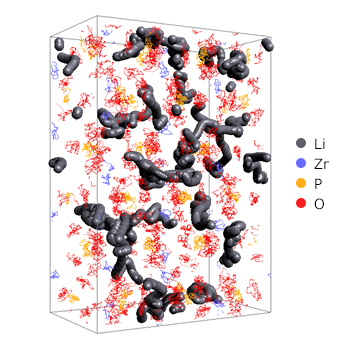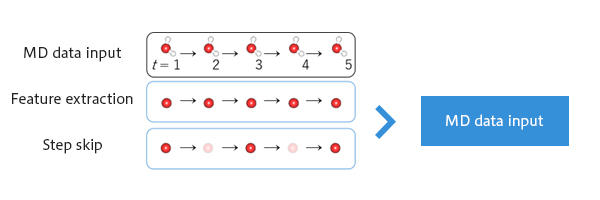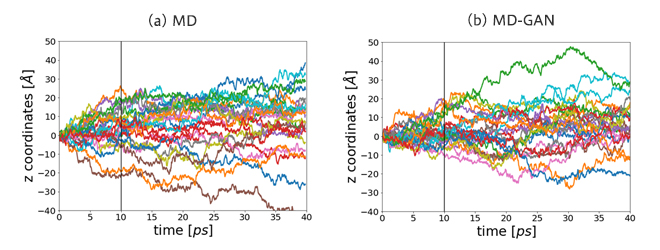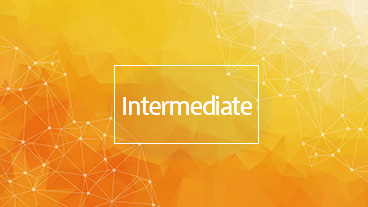Analysis of Li ion diffusion in solid-state battery by MD-GAN
The diffusion behavior of lithium ions in solid-state battery materials was analyzed by combining ab initio Molecular Dynamics (AIMD) with a deep generative model (MD-GAN). Although AIMD is highly accurate, it has high computational cost; by using MD-GAN, long-time diffusion behavior can be predicted from short-time data. For LiZr₂(PO₄)₃, MD-GAN reproduced the same diffusion trends as AIMD. This method enables efficient and accurate evaluation of solid-state battery materials.
Use Cases Highlights
- Generation of long-time data using a deep generative model trained on first-principles MD data
- Capability to learn time-series data
- High-accuracy prediction of long-time behavior
Generation of long-time data from first-principles MD inputs using a deep generative model
The diffusion trajectories of Li ions obtained from ab initio Molecular Dynamics (AIMD) are shown. The random motion of Li ions within the crystal is visualized, enabling understanding of diffusion pathways.

Trajectory of lithium ions in solids (by AIMD)
Capability for time-series data learning
An overview of the structure and learning process of MD-GAN is shown. Features are extracted from MD data, and time-series data are learned and generated by adjusting step skip and the number of records.

Overview of MD-GAN
High-accuracy prediction of long-term behavior
A comparison of Li-ion z-coordinate displacements obtained from MD and MD-GAN is shown. Both exhibit random-walk-like behavior, confirming the high reproducibility of MD-GAN.

z-coordinate displacement of Li ions (MD vs MD-GAN)
Reference
[1] Endo, K. et al., Proceedings of the AAAI Conference on Artificial Intelligence, 32, 2192 (2018).
[2] Kawada, R. et al., Journal of Chemical Information and Modeling, 63, 76-86(2022).
[3] Kawada, R. et al., Soft Matter, 18, 8446-8455(2022).
[4] Soler, J. M. et al., J. Phys. Condens. Matter, 14, 2745 (2002).
[2] Kawada, R. et al., Journal of Chemical Information and Modeling, 63, 76-86(2022).
[3] Kawada, R. et al., Soft Matter, 18, 8446-8455(2022).
[4] Soler, J. M. et al., J. Phys. Condens. Matter, 14, 2745 (2002).
Details of analysis
Inquiries Regarding Products
Have questions about product implementation? Contact us today.





